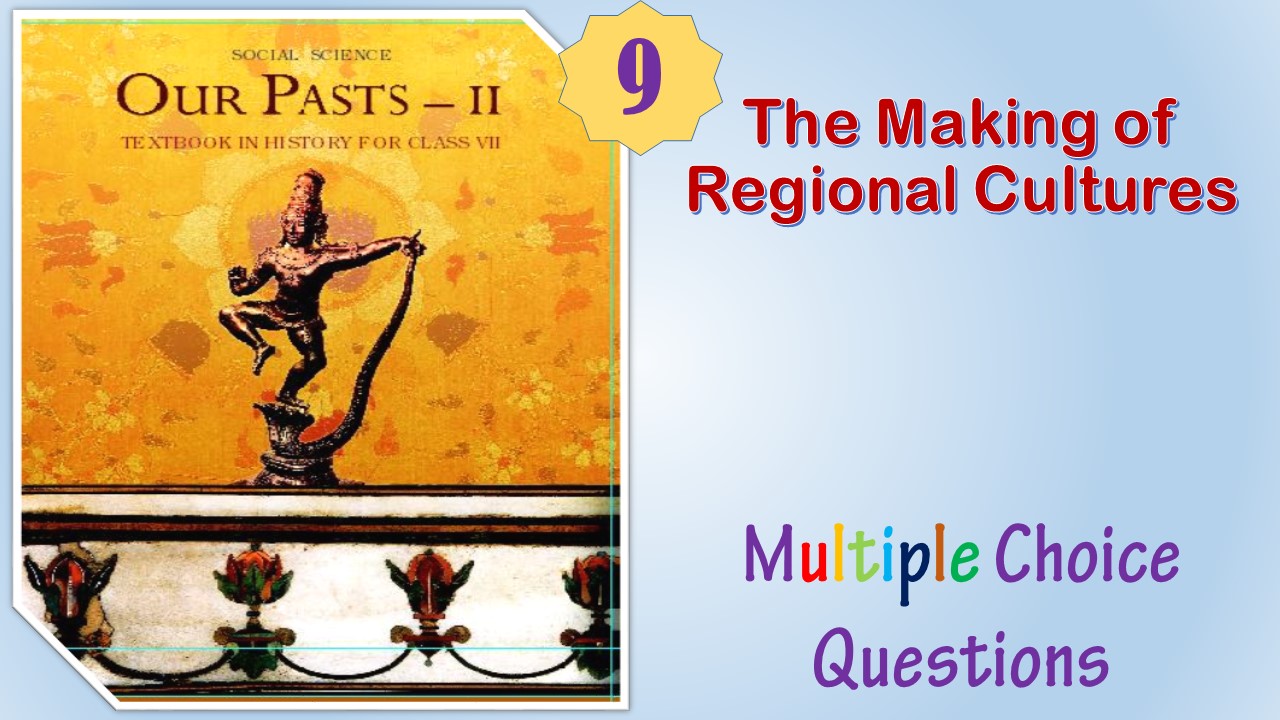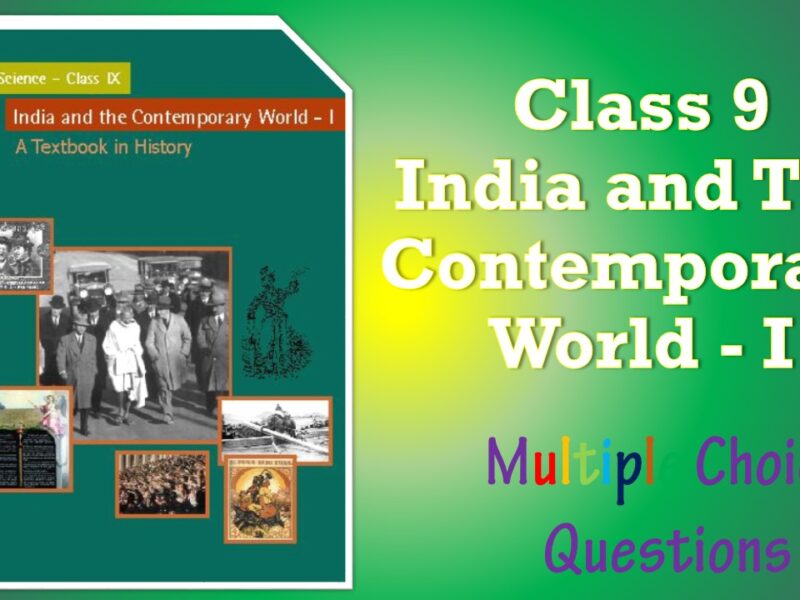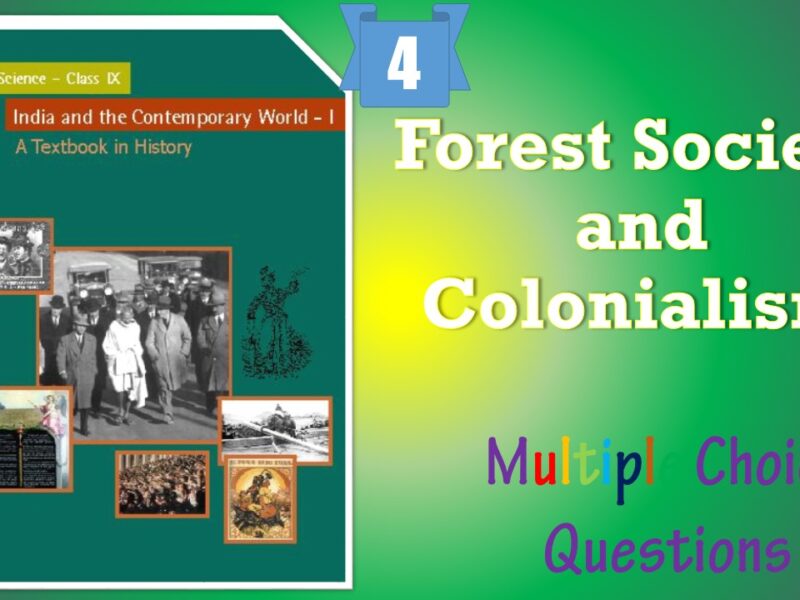Class 7 Social Science History MCQ The Making of Regional Cultures with Answers is Prepared Based on Latest Exam Pattern. Students can solve NCERT Class 7 Social Science History MCQ The Making of Regional Cultures with Answers to know their preparation level.
Students who are searching for NCERT Class 7 Social Science History MCQ The Making of Regional Cultures with Answers are compiled here to get good practice on all fundamentals. Know your preparation level on MCQ Questions for Class 7 Social Science History MCQ The Making of Regional Cultures with Answers. You can also verify your answers from the provided Class 7 Social Science History MCQ The Making of Regional Cultures with Answers. So, ace up your preparation with MCQ of Class 7 Social Science History MCQ & NCERT Textbook solutions Examinations.
CBSE Class 7 Social Science History MCQ
The Making of Regional Cultures
with Answers
Question : Who proclaimed himself as deputy of God?
(A) Shankara
(B) Ramanuja
(C) King Anangbhima
(D) Ruler of Mahodayapuram
Answer : (c) King AnangbhimaShow Answer :
Question : The word Rajputana meant
(A) the Rajput tradition
(B) in 19th century the region of present day Rajasthan
(C) group of Rajputs
(D) none of the above
Answer : (b) in 19th century the region of present day RajasthanShow Answer :
Question : Kuchipudi is a classical dance of which state?
(A) Kerala
(B) Orissa
(C) Andhra Pradesh
(D) West Bengal
Answer : (c) Andhra PradeshShow Answer :
Dance forms that are recognised as classical at present are Bharatanatyam (Tamil Nadu), Kathakali (Kerala) Odissi (Orissa), Kuchipudi (Andhra Pradesh), Manipuri (Manipur).
Question : Name a book written in Manipravalam language?
(A) Ramayan
(B) Gita
(C) Lilatikalam
(D) None of these
Answer : (c) LilatikalamShow Answer :
Manipravalam is a language. The book written in this language is Lilatikalam.
Question : What was Manipravalam?
(A) Statue
(B) Language
(C) King
(D) Saint
Answer : (b) LanguageShow Answer :
Interestingly enough, a fourteenth-century text, the Lilatilakam, dealing with grammar and poetics, was composed in Manipravalam literally, “diamonds and corals” referring to the two languages, Sanskrit and the regional language.
Question : Who proclaimed himself as deputy of God?
(A) Shankara
(B) Ramanuja
(c) King Anangbhima
(d) Ruler of Mahodayapuram
Answer : CShow Answer :
Question : Xuan Zang was a
(A) Chinese travellers
(B) English travellers
(c) Afghani travellers
(d) Japanese travellers
Answer : AShow Answer :
Question : Basohli was
(A) small sized paintings
(B) bold and intense style of miniature paintings
(c) old and very distinctive
(d) traditions
Answer : BShow Answer :
Question : In 1230, Who dedicated his kingdom to the deity and proclaimed himself as the deputy? of the god
(A) king Anangabhima IV
(B) king Anangabhima III
(c) king Anangabhima II
(d) king Anangabhima I
Answer : BShow Answer :
Question : What is Manipravalam?
(A) Language
(B) Kingdom
(c) Dance
(d) None of these
Answer : AShow Answer :
Question : Bengali is the language of:
(A) Bengal
(B) Assam
(c) Bihar
Answer : AShow Answer :
Question : What was Manipravalam?
(A) Statue
(B) Language
(c) King
(d) Saint
Answer : BShow Answer :
Question : Kathak, now associated with several parts of
(A) North India
(B) West India
(c) East India
(d) South India
Answer : AShow Answer :
Question : What was the capital of Bengal under the Mughal control?
(A) Dhaka
(B) Murshidabad
(c) Calcutta
(d) Awadh
Answer : AShow Answer :
Question : How were the Rajput rulers most distinctive?
(A) Rajput rulers were apostles of bravery
(B) Rajput rulers were cowards
(c) Rajput rulers were rich
(d) None of these
Answer : AShow Answer :
Question : The Mughal emperors ________ patronised highly skilled painters who primarily illustrated manuscripts containing historical accounts and poetry
(A) Akbar, Jahangir and Shah Jahan
(B) Akbar, Jahangir and Aurangzeb
(c) Babar, Jahangir and Aurangzeb
(d) Babar, Jahangir and Shah JahanU
Answer : AShow Answer :
Question : Bengal also witnessed a temple-building spree from the late ________ century, which culminated in the ______ century
(A) 15th, 19th
(B) 14th, 17th
(c) 16th, 17th
(d) 16th, 19th
Answer : AShow Answer :
Question : Attribution of living soul to plants, inanimate objects, and natural phenomena
(A) Animism
(B) Anemesm
(c) Anemism
(d) Amimesim
Answer : AShow Answer :
Question : The language spoken in the Chera kingdom of Mahodayapuram was
(A) Sanskrit
(B) Urdu
(c) Malayalam
(d) Persian
Answer : CShow Answer :
Question : Bengal also witnessed a temple-building spree from the late ____ century, which culminated in the _____ century
(A) 15th, 19th
(B) 14th, 17th
(c) 16th, 17th
(d) 16th, 19th
Answer : AShow Answer :
Question : Which state was called Rajputana by the British
(A) Madhya Pradesh
(B) Rajasthan
(c) Punjab
(d) Gujarat
Answer : BShow Answer :
Question : Lilatilakam, was composed in
(A) Mannnipravalam
(B) Manipravalam
(c) Manipurvalam
(d) Manipravolam
Answer : BShow Answer :
Question : The earliest miniatures were on
(A) Palm leaves or wood
(B) Glass
(c) Plastic
(d) Paper
Answer : AShow Answer :
Question : Name the gharanas associated with Kathak?
(A) Rajasthan
(B) Lucknow
(c) Madras
(d) Both a and b
Answer : DShow Answer :
Question : What was Basohli?
(A) Small sized painting
(B) Bold and intense style of miniature painting
(c) Old and very distinctive
(d) Traditions
Answer : BShow Answer :
Question : The word Katha is a word of …..?
(A) Tamil
(B) Hindi
(c) Sanskrit
(d) Malayalam
Answer : CShow Answer :
Question : The kathaks were originally a caste of ……..?
(A) Dancers
(B) Singers
(c) Story tellers
(d) Musicians
Answer : CShow Answer :
Question : ……….literature contains several references to fish?
(A) Rajasthani
(B) Punjabi
(c) Bengali
(d) Orissa
Answer : CShow Answer :
Question : Brihaddharma Purana permitted which caste to eat a certain variety of fish?
(A) Kshatriyas
(B) Brahamanas
(c) Both
(d) None of these
Answer : AShow Answer :
Question : Which state of India has Kathak as its places of origin ?
(A) Uttar Pradesh
(B) Punjab
(c) Delhi
(d) Karnataka
Answer : AShow Answer :
Question : Jagannatha Temple of Puri is located in which presnt day state of India ?
(A) Bengal
(B) Bihar
(c) Tamil Nadu
(d) Odisha
Answer : DShow Answer :
Question : Who proclaimed himself as a deputy of God?
(A) Shankara
(B) Ramanuja
(c) King Anangbhima
(d) Ruler of Mahodayapuram
Answer : CShow Answer :
Question : Kathakali is a traditional dance of …..?
(A) Karnataka
(B) Maharashtra
(c) Kerala
(d) Andhra Pradesh
Answer : CShow Answer :
Question : Kannada is the language of ….?
(A) Kerala
(B) Karnataka
(c) Andhra Pradesh
(d) Tanil Nadu
Answer : CShow Answer :
Question : Bengali is the language of:
(A) Bengal
(B) Assam
(C) Bihar
Answer : (a) BengalShow Answer :
Question : Jagannatha temple is related to:
(A) Shankar Bhagwan
(B) Ma Durga
(C) Vishnu
Answer : (c) VishnuShow Answer :
Question : Ganga dynasty was situated in:
(A) Bengal
(B) Kerala
(C) Rajasthan
Answer : (b) KeralaShow Answer :
Question : The word Katha is a word of:
(A) Sanskrit
(B) Malayalam
(C) Tamil
Answer : (a) SanskritShow Answer :
Question : Kathakali is the traditional dance of:
(A) Andhra Pradesh
(B) Karnataka
(C) Kerala
Answer : (c) KeralaShow Answer :
Question : Kannada is the language of:
(A) Tamil Nadu
(B) Kerala
(C) Karnataka
Answer : (c) KarnatakaShow Answer :
Question : Lilatilakam deals with
(A) Drama and poetics
(B) Drama only
(c) Poetics only
(d) Grammar and poetics
Answer : DShow Answer :
Question : Which Purana permitted Brahmanas to eat certain varieties of fish in Bengal?
(A) Vishnu Purana
(B) Brihaddharma Purana
(C) VarahaPurana
Answer : (b) Brihaddharma PuranaShow Answer :
Question : Bengali as a language originated from:
(A) Sanskrit language
(B) Malayalam language
(C) Tamil language
Answer : (a) Sanskrit languageShow Answer :
Question : Malayalam language was introduced by:
(A) Chola Empire
(B) Mughal Empire
(C) Chera Empire.
Answer : (c) Chera Empire.Show Answer :
Question : Radha-Krishan is famour for:
(A) Katha
(B) Rasalila
(C) Kathak
Answer : (c) KathakShow Answer :
Question : What was Basohli?
(A) Small sized painting
(B) Bold and intense style of miniature painting
(C) Old and very distinctive
(D) Traditions
Answer : (b) Bold and intense style of miniature paintingShow Answer :
By the late seventeenth century this region had developed a bold and intense style of miniature painting called Basohli.
Question : How were the Rajput rulers most distinctive?
(A) Rajput rulers were apostles of bravery
(B) Rajput rulers were cowards
(C) Rajput rulers were rich
(D) None of these
Answer : (a) Rajput rulers were apostles of braveryShow Answer :
The Rajput rulers were apostles of bravery. They fought viliantly and often choose death on the battlefield rather than face defeat.
Question : What is Manipravalam?
(A) Language
(B) Kingdom
(C) Dance
(D) None of these
Answer : (a) LanguageShow Answer :
Manipravalam is a language. The book written in this language is Lilatikalam.
Question : What type of traveller was Xuan Zang?
(A) Japanese
(B) Nepali
(C) Burmese
(D) Chinese
Answer : (d) ChineseShow Answer :
In the seventh century the Chinese traveller Xuan Zang observed that languages related to Sanskrit were in use all over Bengal.
Question : Where is the famous temple of Jagannatha?
(A) Karnataka
(B) Orissa
(C) Kerala
(D) Tamil Nadu
Answer : (b) OrissaShow Answer :
Jagannatha (literally lord of the world a name for Vishnu) is at Puri, Oriss(a)
Question : Name the gharanas associated with Kathak?
(A) Rajasthan
(B) Lucknow
(C) Madras
(D) Both a and b
Answer : (d) Both a and bShow Answer :
The two gharanas or traditions associated with Kathak are Rajasthan (Jaipur) and Lucknow.
Question : Who were the major patrons of Kathak?
(A) Mughal emperor
(B) Rajasthan courtiers
(C) Nawab of Awadh
(D) All of the above
Answer : (d) All of the aboveShow Answer :
The Mughal emperors and their nobles, courtiers of Rajasthan and Nawab of Awadh-Wajid Ali Shah were the major patrons of Kathak.
Question : With what do we associate each region?
(A) Food
(B) Language
(C) Clothing
(D) All of these
Answer : (d) All of theseShow Answer :
Question : The language spoken in the Chera kingdom of Mahodayapuram was
(A) Sanskrit
(B) Urdu
(C) Malayalam
(D) Persian
Answer : (c) MalayalamShow Answer :
Question : Fourteenth-century text of Sanskrit which deals with grammar and poetry was called
(A) Lilatilakam
(B) Miniature
(C) Basohil
(D) Dialect
Answer : (a) LilatilakamShow Answer :
Question : What type of traveller was Xuan Zang?
(A) Japanese
(B) Nepali
(C) Chinese
(D) Burmese
Answer : (c) ChineseShow Answer :
Question : What was the capital of Bengal under the Mughal control?
(A) Dhaka
(B) Murshidabad
(C) Calcutta
(D) Awadh
Answer : (a) DhakaShow Answer :
Question : Brihaddharma Purana permitted which caste to eat certain variety of fish1?
(A) Kshatriyas
(B) Brahamanas
(C) Both
(D) None of these
Answer : (b) BrahamanasShow Answer :
Question : Chera kingdom was established in
(A) 9th century
(B) 10th century
(C) 11th century
(D) 12th century
Answer : (a) 9th centuryShow Answer :
Question : The major patrons of Kathak were
(A) Mongols
(B) Pandayan
(C) Mughals
(D) Rajput
Answer : (c) MughalsShow Answer :
Question : Basohli was
(A) small sized paintings
(B) bold and intense style of miniature paintings
(C) old and very distinctive
(D) traditions
Answer : (b) bold and intense style of miniature paintingsShow Answer :
Question : The conquerors tried to control the temple of Jagannatha at Puri because
(A) they were very devoted to God Jagannatha
(B) the temple was very beautiful
(C) the temple had huge wealth
(D) none of the above
Answer : (c) the temple had huge wealthShow Answer :
Question : Which type of emotions were there in Rajputs ?
(A) Bravery
(B) Valour
(C) Loyalty
(D) All of these
Answer : (d) All of theseShow Answer :
Question : Bengali language was derived from
(A) Hindi
(B) Sanskrit
(C) Persian
(D) Urdu
Answer : (b) SanskritShow Answer :
Question : Which of the following is the language of 13th century Brihaddharma Purana of Bengal?
(A) Persian
(B) Hindi
(C) Urdu
(D) Sanskrit
Answer : (d) SanskritShow Answer :
Fill in the blanks with appropriate words.
Question : ……………. literature contains several references to fish.
Answer : BengaliShow Answer :
Question : The legends of Radha-Krishna were enacted in folk plays known as ……………. .
Answer : rasa lilaShow Answer :
Question : The ……………. were ascetics who engaged in a variety of yogic practices.
Answer : NathsShow Answer :
Question : The ……………. were originally a caste of story-tellers in temple of north India who beautified their
performances with gestures and songs.
Answer : KathakasShow Answer :
Question : The kathaks were originally a caste of ……………. .
Answer : Story-tellersShow Answer :
Question : The earliest miniatures were written on ……………. .
Answer : palm leavesShow Answer :
Question : The Chera kingdom of Mahodayapuram was a part of present day ……………
Answer : KeralaShow Answer :
Question : ……………. and ……………. are the chief food items of the Bengalis.
Answer : Rice, fishShow Answer :
Question : Rajputs are closely associated with the culture of ……………. .
Answer : RajasthanShow Answer :
Question : ……………. built a temple for Purushottama Jagannath(a)
Answer : AnantavarmanShow Answer :
Question : The term Kathak is derived from ……………., a word used in Sanskrit.
Answer : kathaShow Answer :
Question : Kathak was recognized as one of six ……………. in the country after independence.
Answer : classical forms of dancesShow Answer :
Question : In the 19th century, the Rajasthan of today was called ……………. by the British.
Answer : RajputanaShow Answer :
Question : The legends of ………….. were enacted in folk plays called rasa lila.
Answer : Radha-KrishnaShow Answer :
Question : ………… paintings are done in water colour on cloth or paper.
Answer : MiniatureShow Answer :
Question : Lilatilakam was composed in …………
Answer : ManiveravalamShow Answer :
Question : Ruler Anantvarman erected a temple for lord …………. at Puri, Orissa.
Answer : JagannathaShow Answer :
Question : Bengali now recognized as a language was derived from ………….
Answer : SanskritShow Answer :
State whether the given statements are true or false.
Question : Nath literature includes songs of Mayanmati and Gopichandra.
Answer : TrueShow Answer :
Question : Malayalam was the first regional language to be used in official record.
Answer : TrueShow Answer :
Question : The Kathaks were originally a caste of priests in temples of North India.
Answer : FalseShow Answer :
Question : Kathaks developed into two traditions or Gharanas—Rajasthan and Lucknow.
Answer : TrueShow Answer :
Question : Kangra style of miniature was inspired by Shaivite traditions.
Answer : FalseShow Answer :
Question : Brahmanas were allowed to eat fish by Brihaddharma Purana from Bengal.
Answer : TrueShow Answer :




